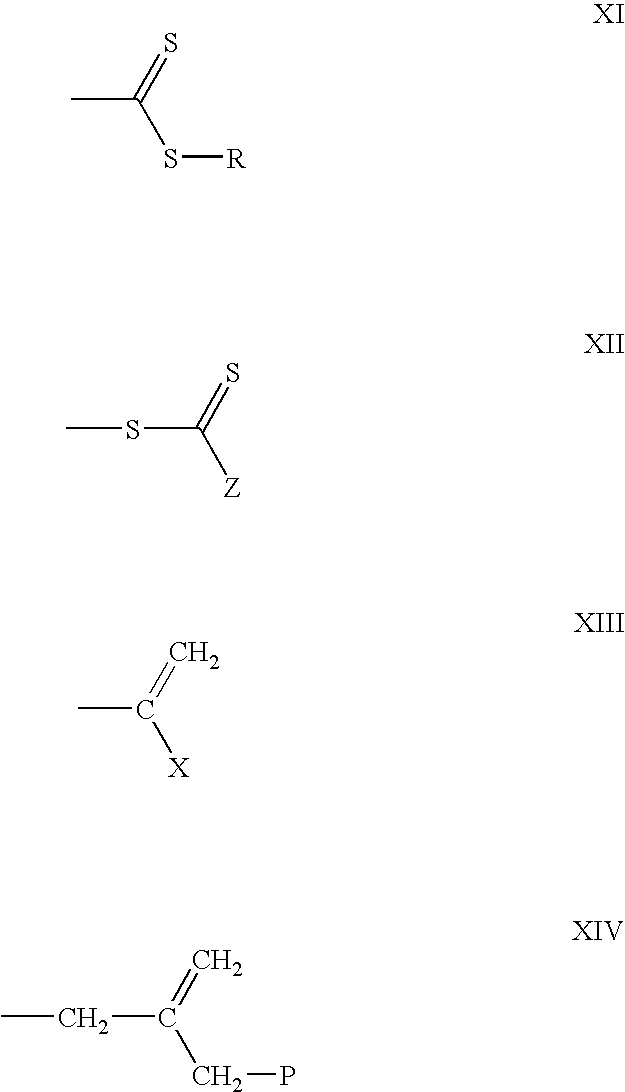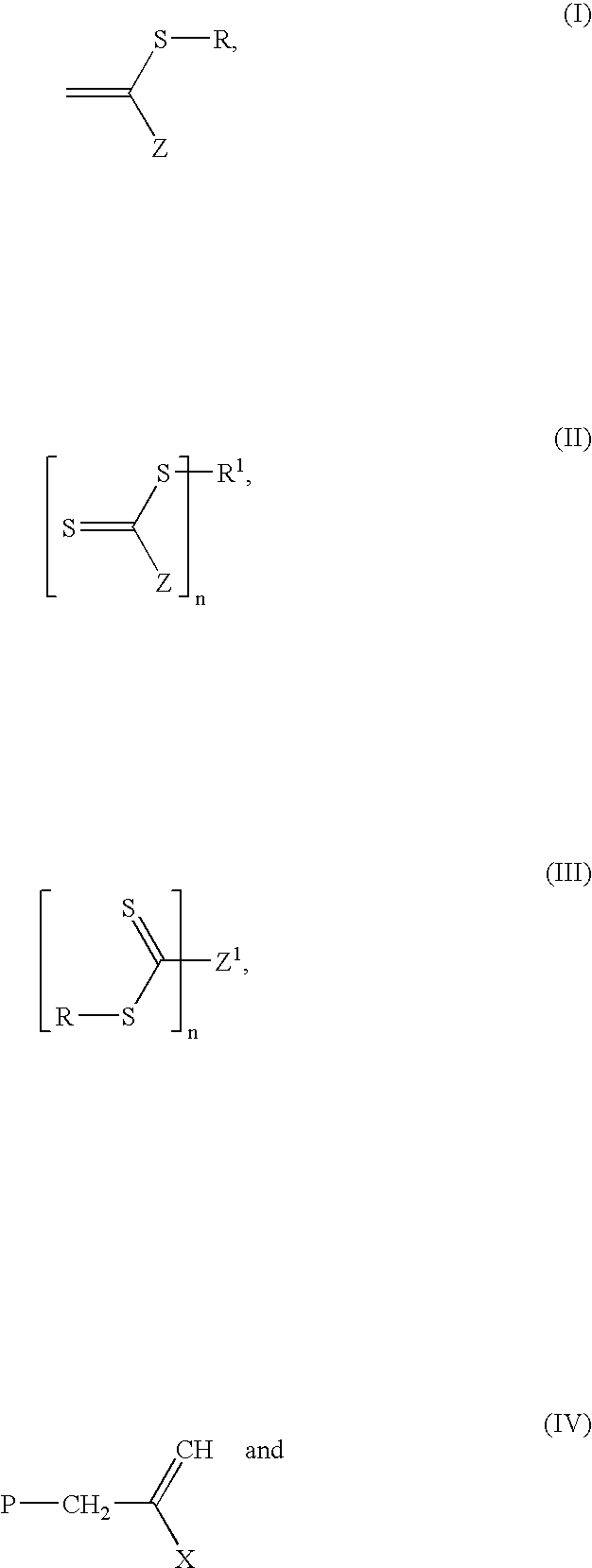Process of microgel synthesis and products produced therefrom
a technology of microgels and products, applied in the direction of coatings, etc., can solve the problems of inability to generalize the application of anionic and group transfer polymerization to make copolymer blocks, intractable networks, and high implementation costs
- Summary
- Abstract
- Description
- Claims
- Application Information
AI Technical Summary
Benefits of technology
Problems solved by technology
Method used
Image
Examples
example 1
Preparation of Methacrylic Acid Macromonomer
[0156]A 5 neck, 1000 mL reactor equipped with mechanical stirrer was charged with 600.5 g distilled water, which was then purged by bubbling N2 gas through the solution for 20 minutes while the reactor contents were heated to 60° C. The monomer feed was commenced at 2.5 mL / min.
[0157]
Feed:Methacrylic acid (inhibited with 150 ppm MEHQ)277gCobalt catalyst [iprCo(III)(dpg-BF2)2]34mg
[0158]The following shots were added to the reactor at the commencement of the monomer feed:
[0159]
Shot 1:Initiator (Wako-VA-044)1.2gDistilled water12gShot 2:Cobalt catalyst30.2mgAcetone (AR)5.0mL
[0160]After 60 minutes had elapsed (from commencement of monomer feed), the following Shot 3 was added:
[0161]
Shot 3Initiator0.6gDistilled water6g
[0162]After the monomer feed was complete, shot 4 was added and the mixture post-reacted at 60° C. for a further 60 minutes:
[0163]
Shot 4Initiator0.6gDistilled water6.1g
[0164]The macromonomer was isolated from the solution on a Rotar...
example 2
The use of poly(methacrylic acid)-block-poly(butyl methacrylate)-block-poly(allyl methacrylate-co-butyl methacrylate) in the formation of a core crosslinked micelle containing a dye
[0183]The poly(methacrylic acid)-block-poly(butyl methacrylate)-block-poly(allyl methacrylate-co-butyl methacrylate) (MAA-BMA-AMA) prepared in Example 1 (0.1 g) was dissolved in methanol (30 mL). While stirring, water (70 mL) was added. A slightly turbid solution with a blue tinge was obtained. To establish the nature of the solution, pyrene (0.004 g) was added as a fluoresence probe (Langmuir, 1990, 6, 514–516) and the mixture allowed to stir for 15 h to equilibrate. Pyrene is an organic dye which is poorly soluble in water. In a 70:30 mixture of water-methanol, pyrene displays a fluoresence excitation spectrum containing the (0,0) band at 330.0 nm (λem396 nm). However the same band was shifted to 332.6 nm in the micellar solution above, indicating that the pyrene was not in open solution. A cast film of...
example 3
[0187]The poly(methacrylic acid)-block-poly(butyl methacrylate)-block-poly(allyl methacrylate-co-butyl methacrylate) prepared in Example 1 (0.5 g) was dissolved in isopropanol (5 mL) and this mixture was added dropwise to stirred water (150 mL) at 95° C. The resulting solution was stirred for 30 min at this temperature during which time the alcohol evaporated. After cooling to 80° C., 0.2 g of the dye was added. Extraction and dispersion of the dye into the solvophobic core of micelles formed by the co-polymer was found to occur within 4 hours.
[0188]At this stage a cross-linking reaction was undertaken. The mixture above was thoroughly degassed by bubbling nitrogen gas through it and maintaining an atmosphere of nitrogen above it. After degassing and stirring for 3 hours, the temperature of the above mixture was maintained at 80° C. and the radical initiator (AIBN) (20 mg) was added. While stirring vigorously, methyl methacrylate (0.1 g) was then added at a rate of 0.0017 g per minu...
PUM
| Property | Measurement | Unit |
|---|---|---|
| weight percent | aaaaa | aaaaa |
| weight percent | aaaaa | aaaaa |
| particle size | aaaaa | aaaaa |
Abstract
Description
Claims
Application Information
 Login to View More
Login to View More - R&D
- Intellectual Property
- Life Sciences
- Materials
- Tech Scout
- Unparalleled Data Quality
- Higher Quality Content
- 60% Fewer Hallucinations
Browse by: Latest US Patents, China's latest patents, Technical Efficacy Thesaurus, Application Domain, Technology Topic, Popular Technical Reports.
© 2025 PatSnap. All rights reserved.Legal|Privacy policy|Modern Slavery Act Transparency Statement|Sitemap|About US| Contact US: help@patsnap.com



